How To Open Dns Manager In Windows Server 2012
DNS (Domain Proper name Arrangement) is a system that lets you translate domain names into IP addresses and vice versa.
A DNS server is a network service that provides and maintains the operation of DNS. The DNS server is an easy and low-cal service that tin can run on most machines. If you don't intend to configure other roles and services on the target automobile, the minimum configuration is enough.
How to ready a DNS server:
- Configuring the network adapter for the DNS server
- Installing the DNS Server Part
- Create a frontward lookup zone
- Creating a reverse lookup zone
- Create an A record
- Describes the Domain Proper noun System (DNS) features that are new or changed in Windows Server 2016.
Configuring the network adapter on the DNS server
Installing a DNS server requires a domain zone. You need to create a private network in your personal account and connect virtual machines to it.
Later the machine is connected to both of the networks, it is of import to call up which connexion needs to be configured. Unremarkably, a network adapter is setup by default from the very starting time with an access to the Internet. At the same time other additional network adapters have no Internet access until the configuration is performed manually:
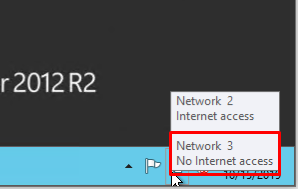
By hovering the cursor over the network icon in the organization tray, you lot tin can find a tooltip with brief information nearly networks. Following the instance above, yous can meet that the joined network is Network 3.
Perform a series of deportment:
- Right-click Start and select Network Connections from the driblet-downwards bill of fare;
- Right-click on the required network adapter and select Backdrop from the bill of fare;
- Select IPv4 In the Backdrop window, and click on the Properties push button;
- Fill in the appropriate fields with the necessary information:
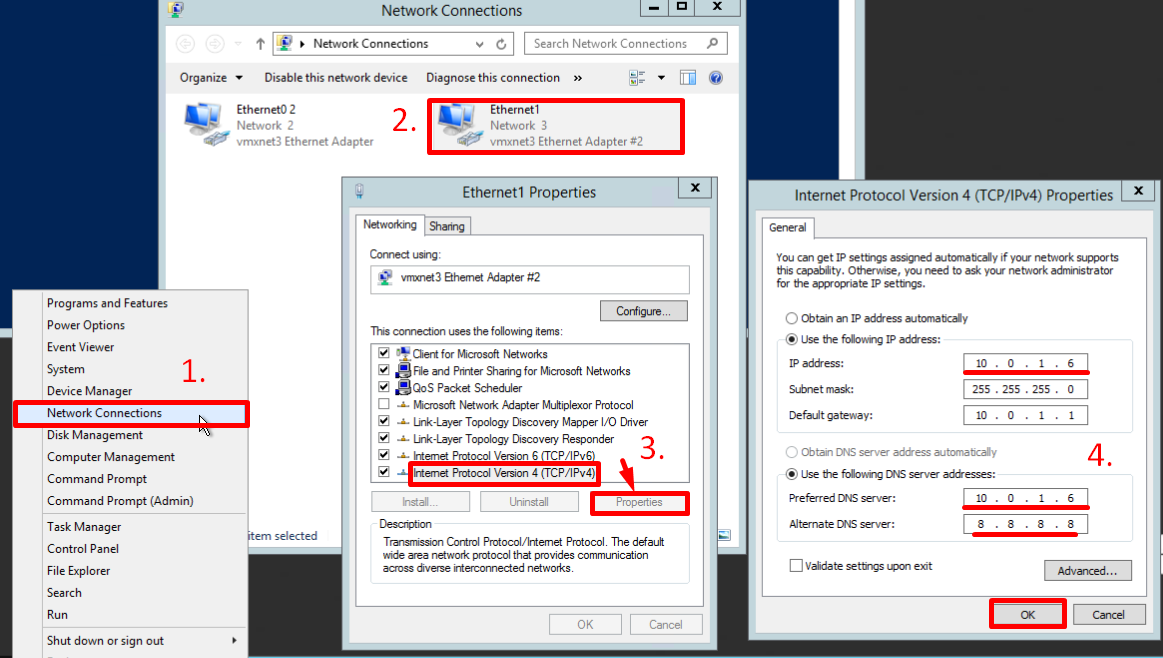
Hither, the machine is assigned equally the preferred DNS server, and the alternate is assigned as dns.google [8.8.8.eight].
Installing the DNS server function
To add new roles to Windows Server, yous use Add together Roles and Features Sorcerer in Server Director.
On the upper navigation bar of the Server Manager click the Manage bill of fare, so select Add together Roles and Features:
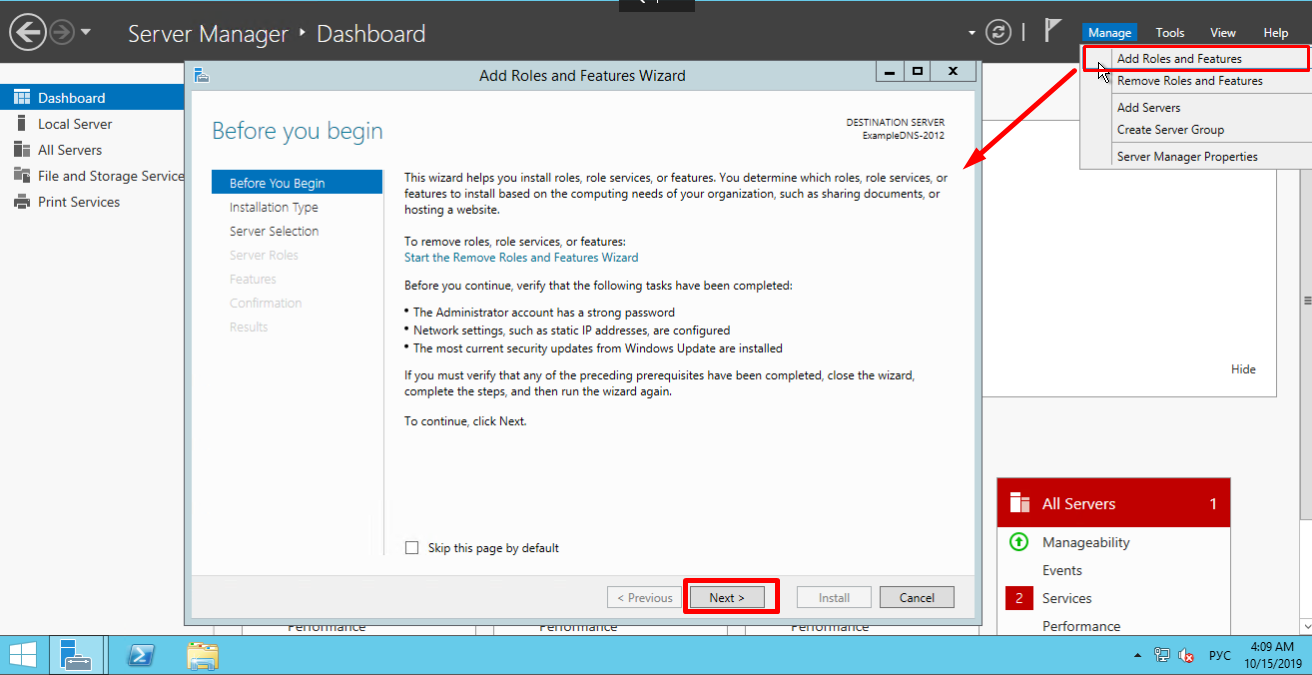
Here, the Wizard recommends you to verify if the following tasks have been completed:
one. The Administrator account has a stiff password.
two. Network settings, such as static IP addresses, are configured.
3. The virtually current security updates from Windows Update are installed.
If you lot are sure that all the conditions are met, click Next;
Select the Role-based or characteristic-based installation and click Next:
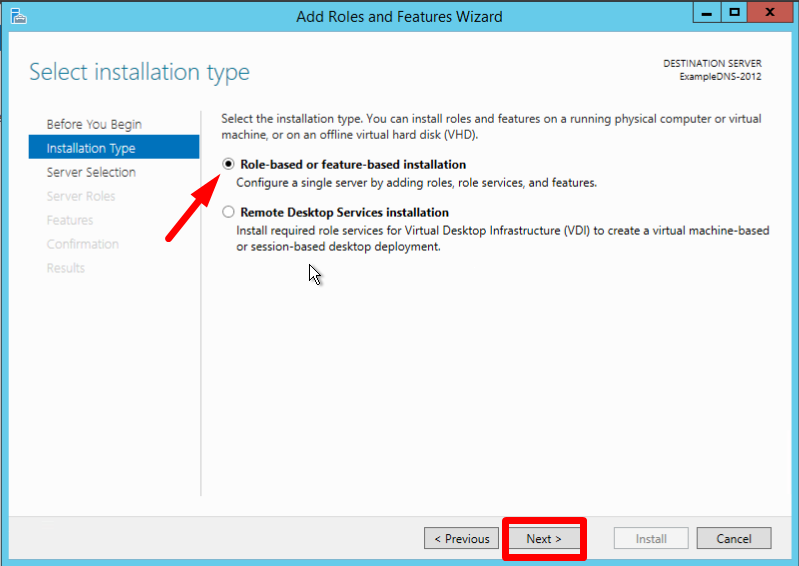
Select a server you want from the server pool and click Next:
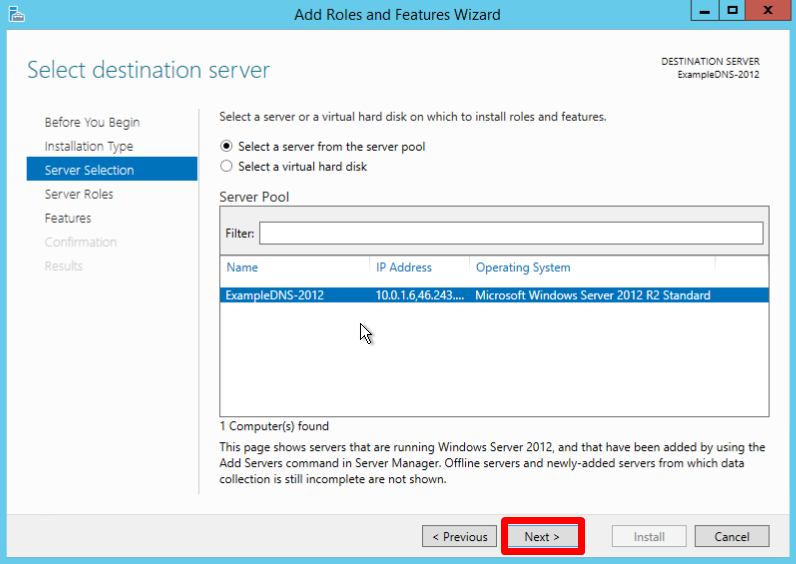
Bank check off the DNS server role and click Next:
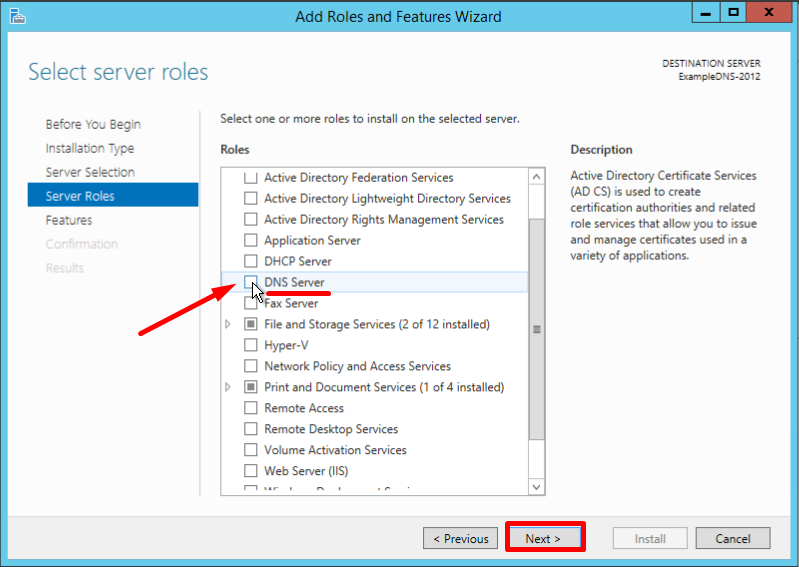
Bank check the list of features to install and ostend by clicking Add Features:
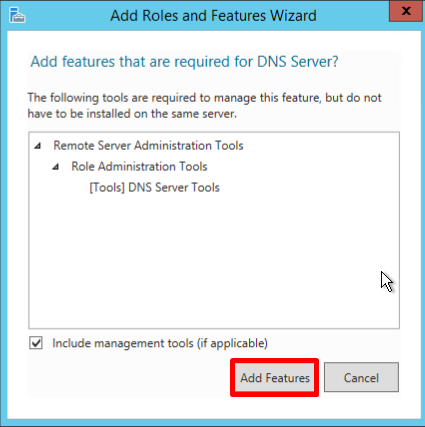
Keep the listing of features as is and click Side by side:
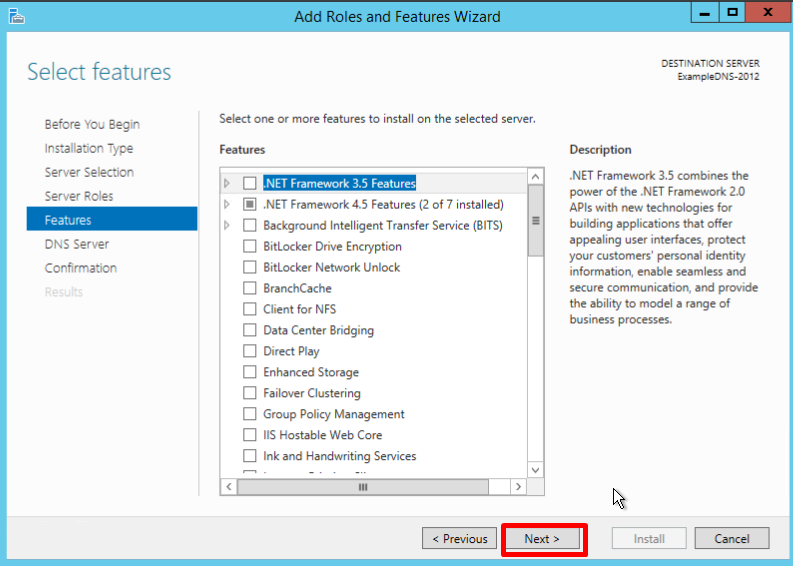
Read the information and click Next:
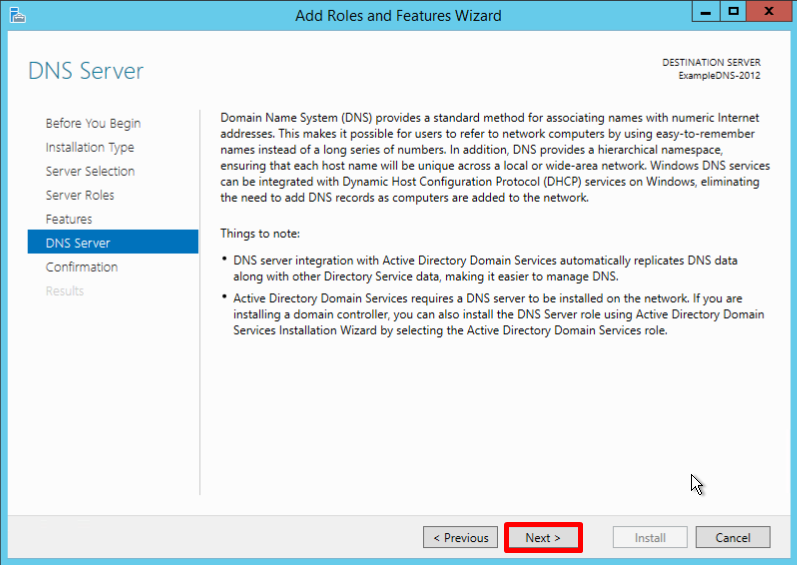
Check the installation configuration one time again and confirm your decision by clicking Install:
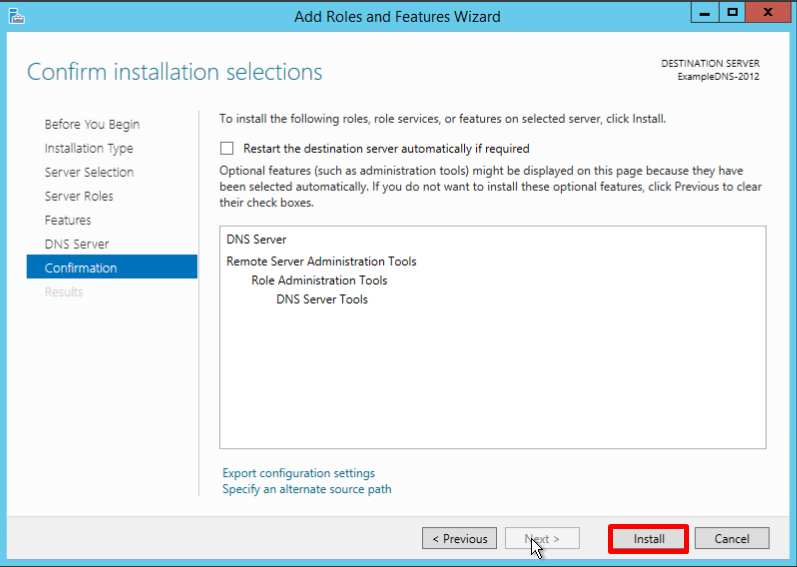
The final confirmation screen lets you know that the installation has been successfully completed, and y'all can close the installation Wizard:

Creating frontward and reverse lookup zones
A domain zone — a ready of domain names within a specific domain.
Frontward lookup zones resolve names to IP addresses.
Reverse lookup zones resolve IP addresses to names.
You have to utilize the DNS Manager to create and manage the zones.
On the upper navigation bar of the Server Director click the Tools menu and select DNS in the drop-down list:

Creating a forward lookup zone
- Right-click on the Forrard Lookup Zones folder, select New Zone. This will open the New Zone Wizard:
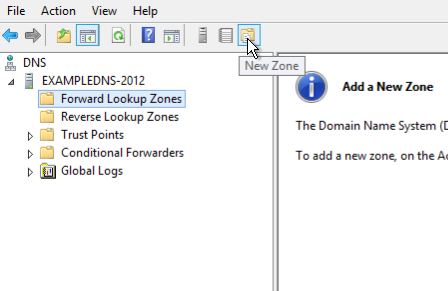
- On the Welcome screen of the Wizard, click Adjacent:
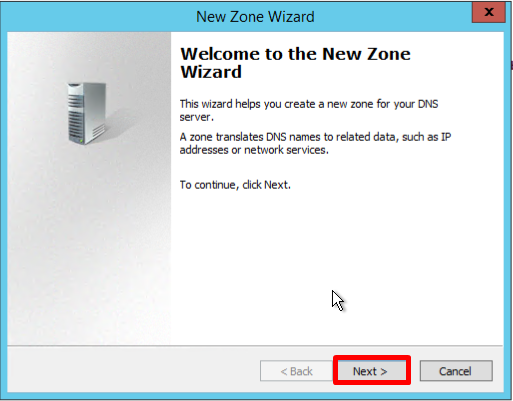
- On the Zone Type screen, Select Primary Zone, and click Next:
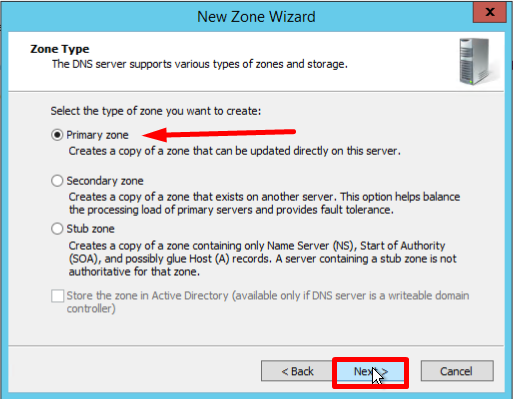
- Enter the name, and click Next:
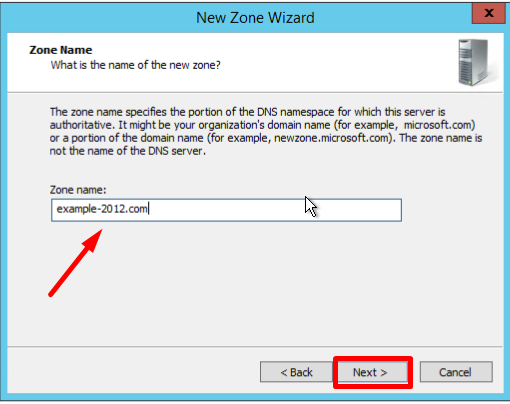
- If necessary, change the proper name of the future zone file and click Next:
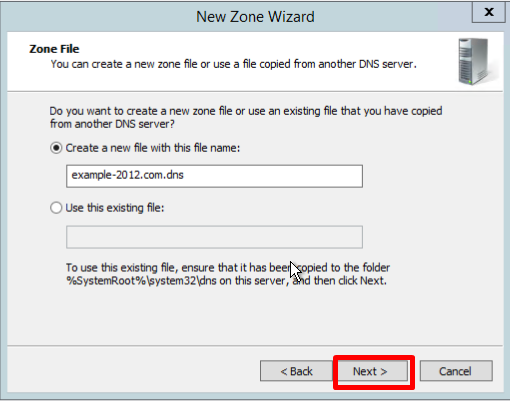
- You must choose whether yous want to let dynamic updates or non. It is not recommended to let this because of a significant vulnerability. Click Next:
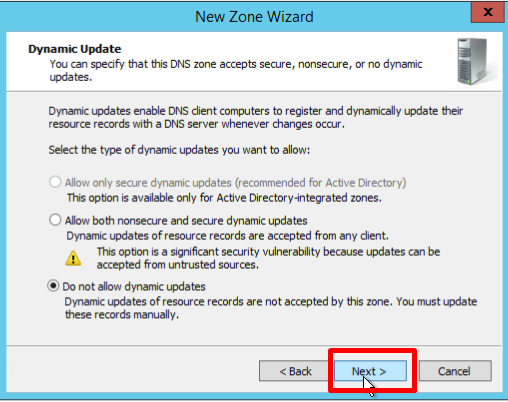
- Verify that the selected settings are correct, click Finish:
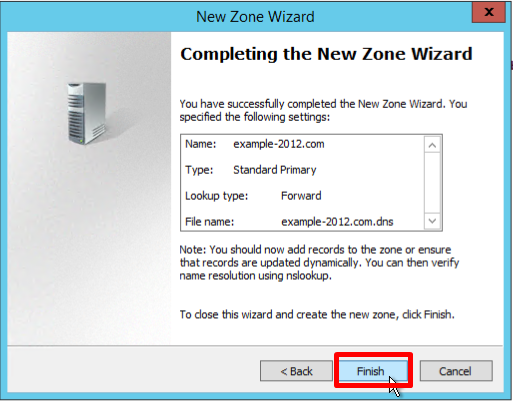
Creating a reverse lookup zone
- Open the DNS Managing director and right-click on the Contrary Lookup Zones folder, select New Zone. This will open the New Zone Wizard:
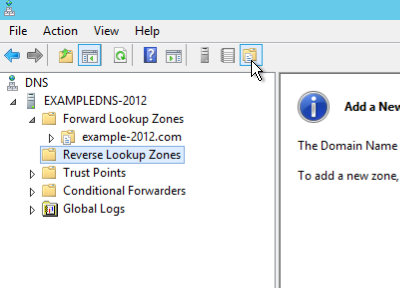
- On the Zone Type screen, Select Main Zone, and click Next:
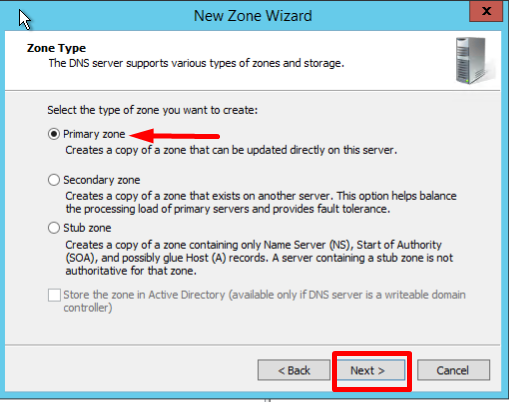
- In the showtime Opposite Lookup Zone Name page, select IPv4, click Next:
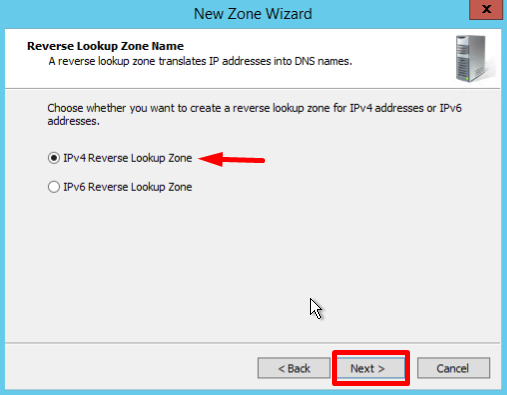
- Type the network ID (the first three octets of the IP address) and click Next:
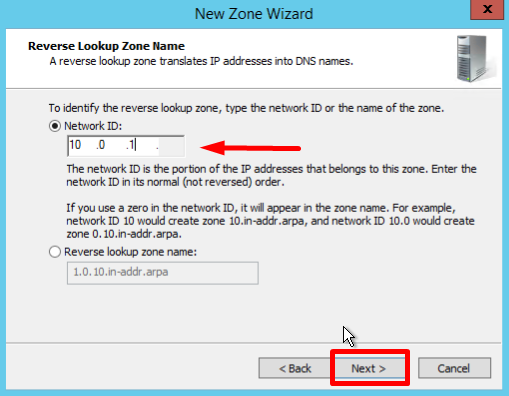
- If necessary, change the name of the time to come zone file and click Next:
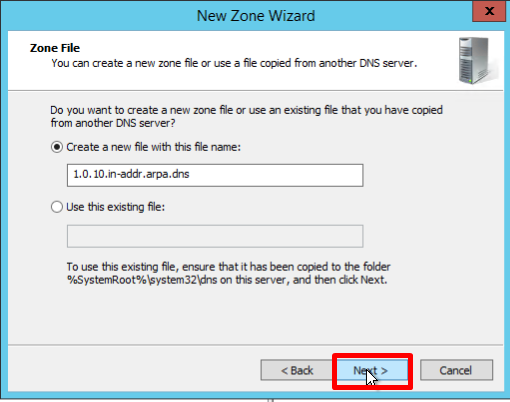
- You must choose whether you desire to let dynamic updates or not. It is non recommended to allow this because of a significant vulnerability. Click Side by side:
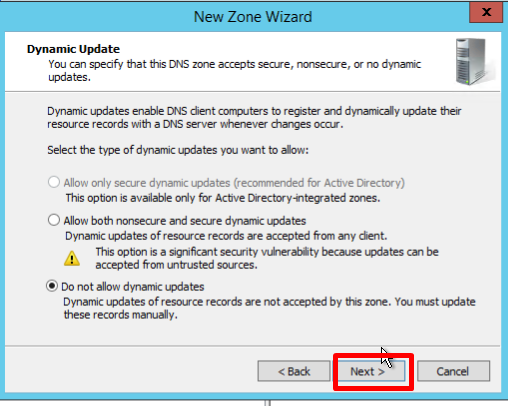
- Verify that the selected settings are right, click End:

Creating a host (A) tape
This section of the guideline is here to mostly cheque all the steps yous performed earlier.
A Resource Record is the unit of information storage and transmission in DNS. RRs are the bones building blocks of host-name and IP information and are used to resolve all DNS queries.
Record A — a record that lets y'all map hostnames to an IP address of the host.
Record PTR — is the reverse version of an A Record.
- Open the Forward Lookup Zones binder in the DNS Manager and discover the zone folder. Correct-click on the correct part of the DNS Managing director and select New Host (a or AAA):
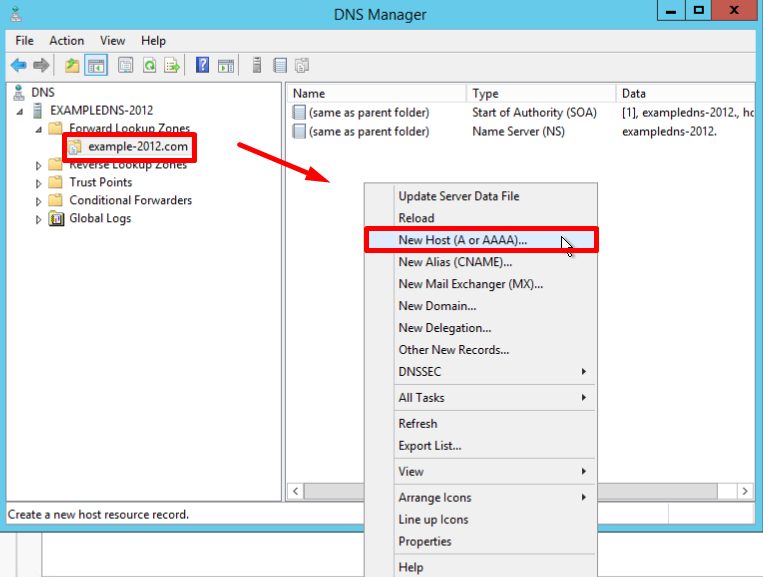
- New Host page opens. In Name, blazon a proper noun of the host (with no domain, it volition use the name of the Zone as a domain) and your IP address. Bank check off the department "Create associated pointer (PTR) record", to verify if both Forward and Opposite Lookup Zones are operating properly:
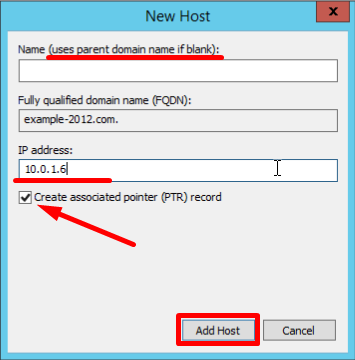
If the Proper name field is blank it uses parent domain proper noun.
- You lot tin can also add records for other servers:
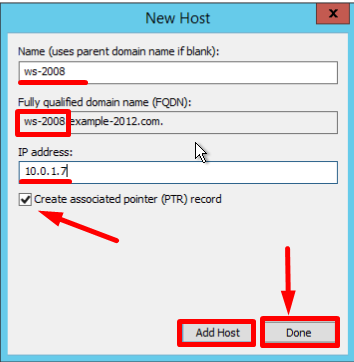
- Once you are finished, click Done.
Making certain everything is correct
- Check the changes in the folders of the zones (in the example beneath y'all tin can see 2 records appeared in each of them):
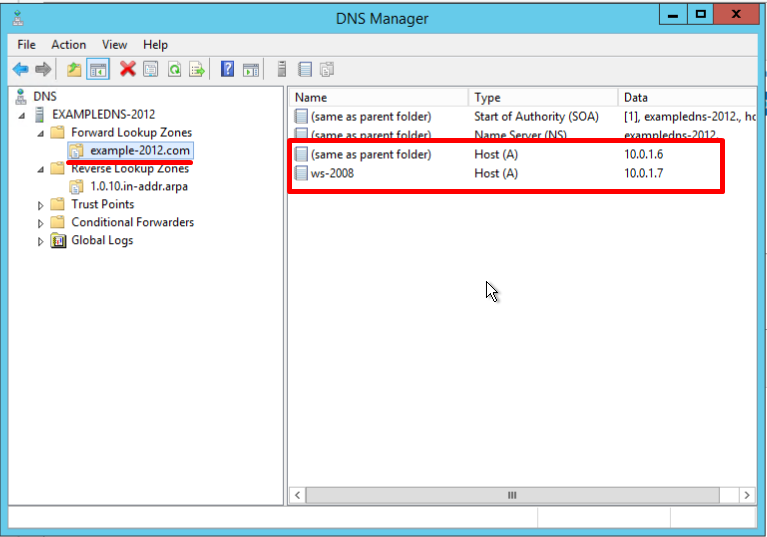
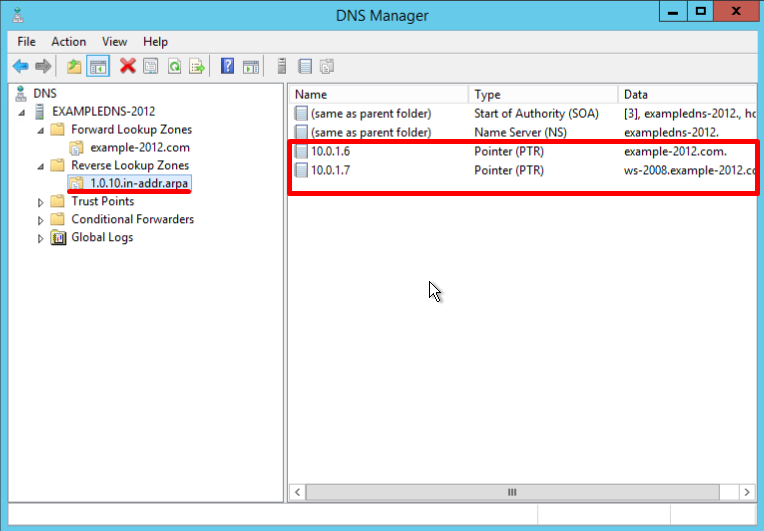
- Open the command line (cmd) or PowerShell and run the nslookup control:
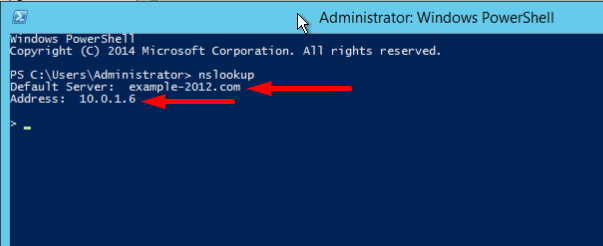
Information technology shows that the default DNS server is case-2012.com with the address 10.0.1.6.
To make sure that the Forward and Reverse Zones are operating properly, you can ship ii queries:
- To query the domain;
- To query the IP address:
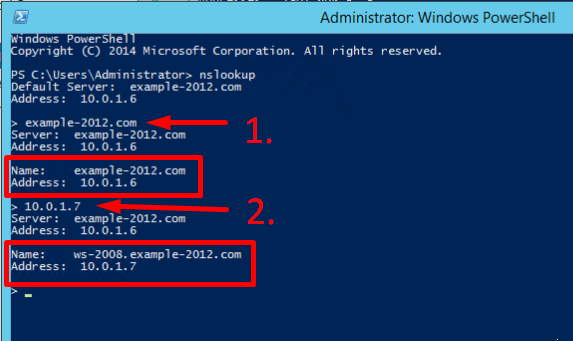
In the instance, we accept got appropriate responses for both queries.
- There is an option to send a query to an external resource:
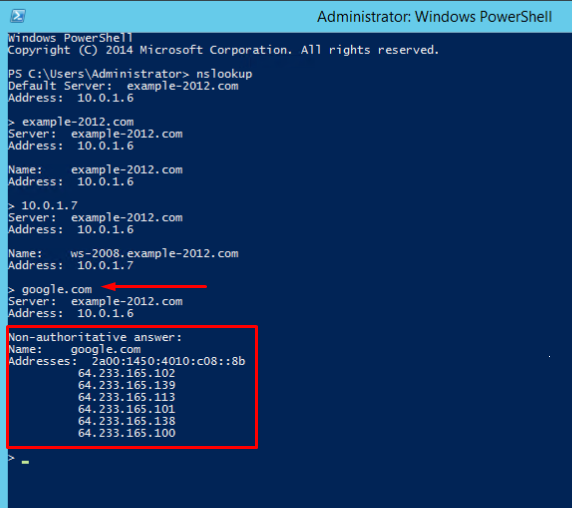
We see a new line here "Not-authoritative respond". This means that our DNS server does not contain domain's original zone files. Although the information displayed below, received from an administrative server, it is not itself administrative in this case.
To compare, even so queries were made on the server where the forward and reverse zones were not configured:
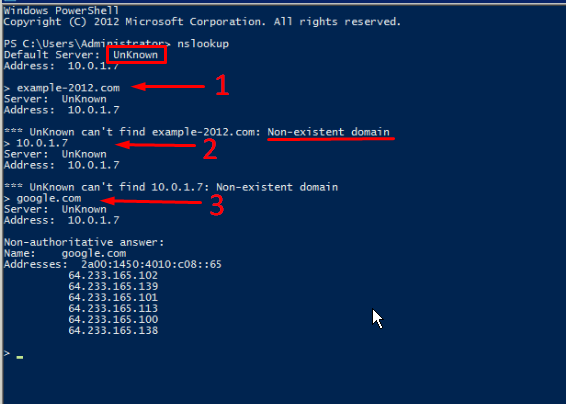
Here, the auto assigned itself as a default DNS server. The DNS server domain name is displayed as unknown because there are no resource records for the IP address (10.0.1.7). For the same reason, the second query returns an error (Not-existent domain).
Describtion of the Domain Name Organisation (DNS) features which are new or changed in Windows Server 2016.
In Windows Server 2016, DNS Server offers updates in the following areas:
- DNS Server Policies
- Response Charge per unit Limit (RRL)
- DNS Based Named Entity Authentication (DANE)
- Unknown record support
- IPv6 root hints
- Windows PowerShell Support
DNS Server Policies
Now you can apply these features:
- DNS Policy for Geo-Location based traffic direction
- Intelligent DNS responses based on the fourth dimension of day, to manage a single DNS server configured for separate-brain deployment
- Apply filters on DNS queries, and more.
Specific clarification of these features:
Application Load Balancing
When you have deployed multiple instances of an application at dissimilar locations, you can utilize DNS policy to balance the traffic load between the different application instances, dynamically allocating the traffic load for the awarding.
Geo-Location Based Traffic Direction.
You tin can utilise DNS Policy to allow master and secondary DNS servers to reply to DNS customer queries based on the geographical location of both the customer and the resource to which the client is attempting to connect, providing the client with the IP address of the closest resource.
Separate Brain DNS
With split up-brain DNS, DNS records are split up into different Zone Scopes on the same DNS server, and DNS clients receive a response based on whether the clients are internal or external clients. You can configure split-brain DNS for Active Directory integrated zones or for zones on standalone DNS servers.
Filtering
You tin configure DNS policy to create query filters that are based on criteria that you supply. Query filters in DNS policy let y'all to configure the DNS server to answer in a custom manner based on the DNS query and DNS customer that sends the DNS query.
Forensics
You tin can use DNS policy to redirect malicious DNS clients to a not-real IP accost instead of directing them to the calculator they are trying to reach.
Time of twenty-four hour period based redirection
Yous tin can utilize DNS policy to distribute application traffic across different geographically distributed instances of an application by using DNS policies that are based on the time of day.
You tin can also use DNS policies for Active Directory integrated DNS zones.
Response Rate Limiting (RRL)
ТYou tin configure RRL settings to control how to reply to requests to a DNS client when your server receives several requests targeting the same customer.
By doing this, you lot can forestall someone from sending a Denial of Service (Dos) assail using your DNS servers.
For instance, a bot net tin ship requests to your DNS server using the IP address of a tertiary computer as the requestor. Without RRL, your DNS servers might respond to all the requests, flooding the tertiary estimator.
When you employ RRL, you tin can configure the following settings:
Responses per 2d This is the maximum number of times the aforementioned response is given to a client within one 2nd.
Errors per second This is the maximum number of times an mistake response is sent to the aforementioned client within 1 2nd.
Window This is the number of seconds for which responses to a customer are suspended if besides many requests are made.
Leak rate This is how oft the DNS server responds to a query during the time responses are suspended. For instance, if the server suspends responses to a customer for 10 seconds, and the leak rate is 5, the server still responds to one query for every 5 queries sent. This allows the legitimate clients to become responses even when the DNS server is applying response charge per unit limiting on their subnet or FQDN.
TC rate This is used to tell the client to try connecting with TCP when responses to the client are suspended. For instance, if the TC rate is 3, and the server suspends responses to a given client, the server problems a request for TCP connection for every three queries received. Make sure the value for TC rate is lower than the leak charge per unit, to give the client the option to connect via TCP before leaking responses.
Maximum responses This is the maximum number of responses the server problems to a client while responses are suspended.
Allowlist domains This is a list of domains to be excluded from RRL settings.
Allowlist subnets This is a list of subnets to be excluded from RRL settings.
Allowlist server interfaces This is a listing of DNS server interfaces to be excluded from RRL settings.
DNS Based Named Entity Authentication (DANE)
You can use DANE back up (RFC 6394 and 6698) to specify to your DNS clients what CA they should wait certificates to be issued from for domains names hosted in your DNS server. This prevents a form of man-in-the-middle assault where someone is able to decadent a DNS enshroud and indicate a DNS name to their ain IP address.
Unknown record support
An "Unknown Record" is an RR whose RDATA format is not known to the DNS server. The newly added support for unknown record (RFC 3597) types ways that you can add the unsupported record types into the Windows DNS server zones in the binary on-wire format. The Windows caching resolver already has the ability to process unknown record types. Windows DNS server does not practice any record specific processing for the unknown records, only sends information technology back in responses if queries are received for it.
IPv6 root hints
The IPV6 root hints, as published by IANA, accept been added to the Windows DNS server. The net name queries tin now use IPv6 root servers for performing proper noun resolutions.
Windows PowerShell support
The following new Windows PowerShell cmdlets and parameters are introduced in Windows Server 2016:
Add-DnsServerRecursionScope - This cmdlet creates a new recursion telescopic on the DNS server. Recursion scopes are used past DNS policies to specify a list of forwarders to be used in a DNS query.
Remove-DnsServerRecursionScope - This cmdlet removes existing recursion scopes.
Set up-DnsServerRecursionScope - This cmdlet changes the settings of an existing recursion scope.
Get-DnsServerRecursionScope - This cmdlet retrieves information about existing recursion scopes.
Add-DnsServerClientSubnet - This cmdlet creates a new DNS client subnet. Subnets are used by DNS policies to place where a DNS client is located.
Remove-DnsServerClientSubnet - This cmdlet removes existing DNS client subnets.
Set-DnsServerClientSubnet - This cmdlet changes the settings of an existing DNS client subnet.
Get-DnsServerClientSubnet - This cmdlet retrieves information about existing DNS client subnets.
Add-DnsServerQueryResolutionPolicy - This cmdlet creates a new DNS query resolution policy. DNS query resolution policies are used to specify how, or if, a query is responded to, based on different criteria.
Remove-DnsServerQueryResolutionPolicy - This cmdlet removes existing DNS policies.
Set up-DnsServerQueryResolutionPolicy - This cmdlet changes the settings of an existing DNS policy.
Get-DnsServerQueryResolutionPolicy - This cmdlet retrieves information well-nigh existing DNS policies.
Enable-DnsServerPolicy - This cmdlet enables existing DNS policies.
Disable-DnsServerPolicy - This cmdlet disables existing DNS policies.
Add-DnsServerZoneTransferPolicy - This cmdlet creates a new DNS server zone transfer policy. DNS zone transfer policies specify whether to deny or ignore a zone transfer based on different criteria.
Remove-DnsServerZoneTransferPolicy - This cmdlet removes existing DNS server zone transfer policies.
Set-DnsServerZoneTransferPolicy - This cmdlet changes settings of an existing DNS server zone transfer policy.
Get-DnsServerResponseRateLimiting - This cmdlet retrieves RRL settings.
Gear up-DnsServerResponseRateLimiting - This cmdlet changes RRL settigns.
Add together-DnsServerResponseRateLimitingExceptionlist - This cmdlet creates an RRL exception list on the DNS server.
Get-DnsServerResponseRateLimitingExceptionlist- This cmdlet retrieves RRL excception lists.
Remove-DnsServerResponseRateLimitingExceptionlist - This cmdlet removes an existing RRL exception list.
Fix-DnsServerResponseRateLimitingExceptionlist - This cmdlet changes RRL exception lists.
Add-DnsServerResourceRecord - This cmdlet was updated to support unknown tape type.
Get-DnsServerResourceRecord - This cmdlet was updated to support unknown tape type.
Remove-DnsServerResourceRecord - This cmdlet was updated to support unknown tape type.
Set-DnsServerResourceRecord- This cmdlet was updated to back up unknown record type
For more information, run into the following Windows Server 2016 Windows PowerShell command reference topics.
Powershell DNS Server
Powershell DNS Customer
Source: https://serverspace.io/support/help/configuring-a-dns-server-on-windows-server-2012-or-later/
Posted by: stantonexpon1997.blogspot.com

0 Response to "How To Open Dns Manager In Windows Server 2012"
Post a Comment